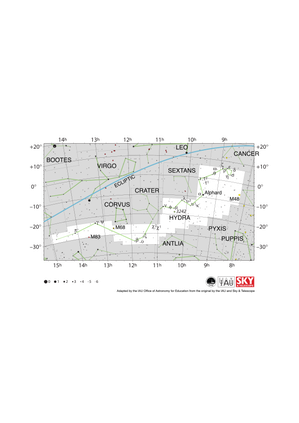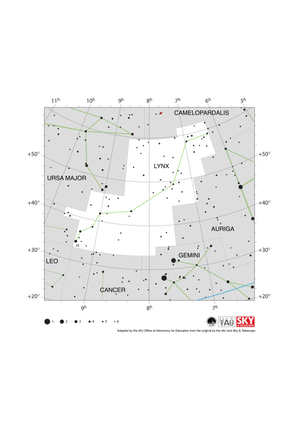Glossarbegriffe: Krebs
Description: Der Krebs (lateinisch Cancer) ist eines der Sternbilder des Tierkreises, d. h. die Sterne, aus denen dieses Sternbild besteht, befinden sich in dem Teil des Himmels, der sich mit der Ekliptik (der Ebene, die durch die Bahn der Erde um die Sonne definiert ist) schneidet. Daher können wir von der Erde aus regelmäßig die Sonne und auch die Planeten im Sternbild Krebs finden. Im Falle der Sonne ist dies Ende Juli und Anfang August der Fall - zu dieser Zeit können wir die Sterne des Sternbilds natürlich nicht sehen. Vor zweitausend Jahren befand sich die Sonne während der Sommersonnenwende auf der Nordhalbkugel im Krebs: Daher wird der nördliche Wendekreis auch als Wendekreis des Krebses bezeichnet. Aufgrund der Präzession der Erdachse steht die Sonne zur Sommersonnenwende auf der Nordhalbkugel nicht mehr im Krebs. Der Krebs ist eines der 88 modernen Sternbilder, die von der Internationalen Astronomischen Union definiert wurden, aber er geht viel weiter zurück - er war bereits eines der 48 Sternbilder, die vom Astronomen Claudius Ptolemäus im 2. Jahrhundert beschrieben wurden.
Zugehörige Glossarbegriffe:
See this term in other languages
Term and definition status: The original definition of this term in English have been approved by a research astronomer and a teacher The translation of this term and its definition is still awaiting approval
The OAE Multilingual Glossary is a project of the IAU Office of Astronomy for Education (OAE) in collaboration with the IAU Office of Astronomy Outreach (OAO). The terms and definitions were chosen, written and reviewed by a collective effort from the OAE, the OAE Centers and Nodes, the OAE National Astronomy Education Coordinators (NAECs) and other volunteers. You can find a full list of credits here. All glossary terms and their definitions are released under a Creative Commons CC BY-4.0 license and should be credited to "IAU OAE".
If you notice a factual or translation error in this glossary term or definition then please get in touch.
Zugehörige Medien
Die hellsten Sterne am Himmel
Bildnachweis: Giorgia Hofer/IAU OAE
License: CC-BY-4.0 Creative Commons Namensnennung 4.0 International (CC BY 4.0) icons
Related Diagrams
Cancer Constellation Map
Bildnachweis: Adapted by the IAU Office of Astronomy for Education from the original by IAU/Sky & Telescope
License: CC-BY-4.0 Creative Commons Namensnennung 4.0 International (CC BY 4.0) icons
Leo Constellation Map
Bildnachweis: Adapted by the IAU Office of Astronomy for Education from the original by IAU/Sky & Telescope
License: CC-BY-4.0 Creative Commons Namensnennung 4.0 International (CC BY 4.0) icons
Hydra Constellation Map
Bildnachweis: Adapted by the IAU Office of Astronomy for Education from the original by the IAU and Sky & Telescope
License: CC-BY-4.0 Creative Commons Namensnennung 4.0 International (CC BY 4.0) icons
Lynx Constellation Map
Bildnachweis: Adapted by the IAU Office of Astronomy for Education from the original by the IAU and Sky & Telescope
License: CC-BY-4.0 Creative Commons Namensnennung 4.0 International (CC BY 4.0) icons













